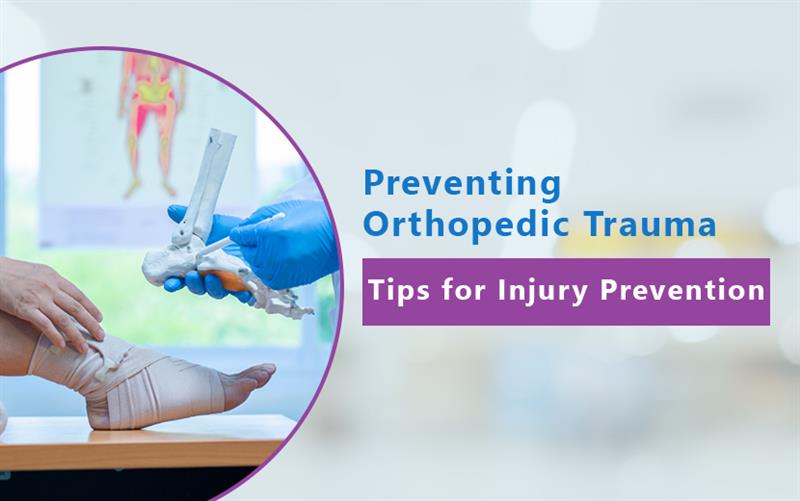Orthopedic trauma encompasses a spectrum of injuries affecting the musculoskeletal system, including bones, joints, ligaments, and muscles. In Ahmedabad, the incidence of bone injuries is notably high, often resulting from accidents, sports activities, or falls. Preventing such injuries is crucial for maintaining mobility and quality of life. This comprehensive guide delves into effective strategies for preventing orthopedic trauma, emphasizing practical steps individuals can take to safeguard their musculoskeletal health.
Table of Contents
ToggleUnderstanding Orthopedic Trauma
Orthopedic trauma refers to physical injuries that impact the musculoskeletal system. Common examples include:
- Fractures: Breaks in bones due to impact or stress.
- Dislocations: Joints forced out of their normal position.
- Ligament Tears: Damage to the connective tissues stabilizing joints.
- Tendon Ruptures: Tears in the tissues connecting muscles to bones.
These injuries can occur due to various factors such as accidents, sports activities, or falls.
Importance of Injury Prevention
Preventing orthopedic trauma is essential to:
- Reduce the incidence of fractures and dislocations: Minimizing the occurrence of these injuries through preventive measures.
- Minimize the need for surgical interventions: Avoiding surgeries by preventing injuries.
- Enhance overall mobility and quality of life: Maintaining physical function and independence.
- Decrease healthcare costs associated with trauma treatment.
Common Causes of Orthopedic Injuries
Understanding the common causes can aid in prevention:
- Accidents: Motor vehicle collisions, falls, and workplace incidents.
- Sports Activities: High-impact sports like football, cricket, and basketball.
- Repetitive Movements: Overuse injuries from activities like running or lifting.
- Environmental Factors: Slippery surfaces, poor lighting, and uneven terrain.
Tips for Preventing Orthopedic Trauma
1. Maintain a Healthy Weight
Excess body weight places additional stress on joints, particularly weight-bearing ones like the knees and hips. Maintaining a healthy weight reduces the risk of joint degeneration and bone injury in Ahmedabad.
2. Engage in Regular Exercise
Regular physical activity strengthens muscles and bones, enhancing stability and reducing the risk of falls. Include weight-bearing exercises such as walking, jogging, or resistance training.
3. Warm-Up and Cool Down
Always perform a proper warm-up before engaging in physical activities. This increases blood flow to muscles and prepares them for exertion. Cooling down afterward supports muscle recovery and flexibility.
4. Use Proper Technique
Whether lifting weights or playing sports, using the correct technique minimizes stress on joints. Consult a professional trainer or a trauma doctor near you for guidance.
5. Wear Appropriate Footwear
Supportive footwear cushions your joints and reduces injury risk. Choose well-fitting shoes appropriate for your activities.
6. Incorporate Strength and Flexibility Training
Building muscle strength and improving flexibility helps stabilize joints and reduce injury risk. Focus on exercises for the core, back, and lower body.
7. Stay Hydrated
Hydration supports joint lubrication and muscle performance. Dehydration can increase the risk of strains, sprains, and cramps.
8. Ensure Safe Home and Work Environments
Prevent slips and falls by securing rugs, improving lighting, and using assistive devices like handrails. Ergonomic furniture reduces musculoskeletal strain.
9. Take Rest Days
Rest and recovery are key to preventing overuse injuries. Balance your activity levels with adequate downtime.
10. Seek Professional Guidance
Consulting a trauma doctor near you is important, especially if you are involved in high-risk activities or have a history of joint injuries.
Role of Nutrition in Bone Health
Nutrition plays a critical role in preventing bone injury in Ahmedabad and maintaining skeletal health. Ensure adequate intake of:
- Calcium: Found in dairy, leafy greens, and fortified foods.
- Vitamin D: Obtained through sunlight, supplements, and certain foods.
- Magnesium: Found in whole grains, nuts, and seeds.
These nutrients help preserve bone density and support joint health.
Importance of Regular Check-Ups
Visiting an orthopedic hospital in Ahmedabad for regular evaluations allows early detection of musculoskeletal issues. Timely diagnosis leads to better treatment outcomes and minimizes complications.
Conclusion
Preventing orthopedic trauma in Ahmedabad requires conscious lifestyle changes, proactive safety practices, and periodic medical consultations. People can significantly reduce their risk of bone injury in Ahmedabad through mindful living and by engaging with experienced specialists.
One such expert is Dr. Hardik Padhiyar, a respected name at an established orthopedic hospital in Ahmedabad. With his specialized training in trauma care, he provides precise diagnoses, surgical interventions when necessary, and emphasizes personalized preventive strategies. His patients benefit not only from treatment but also from education that reduces recurrence risks.
Taking early action with the support of professionals like Dr. Hardik Padhiyar and following evidence-based prevention strategies ensures a life of mobility, independence, and resilience against orthopedic trauma in Ahmedabad.






